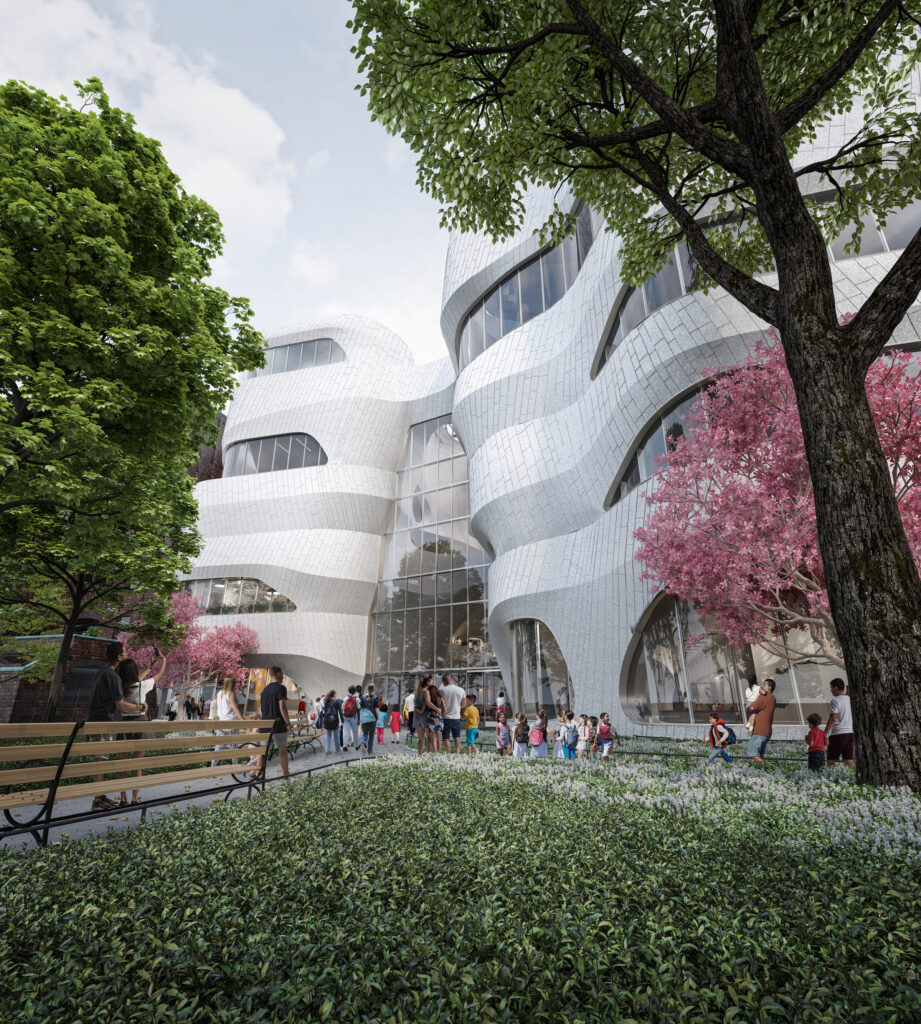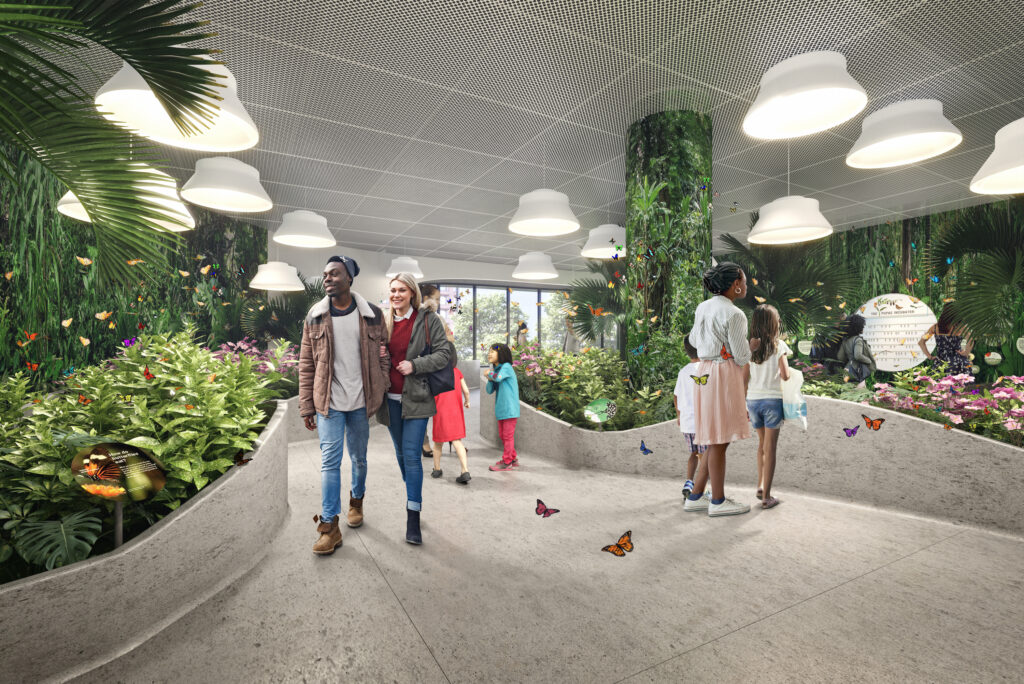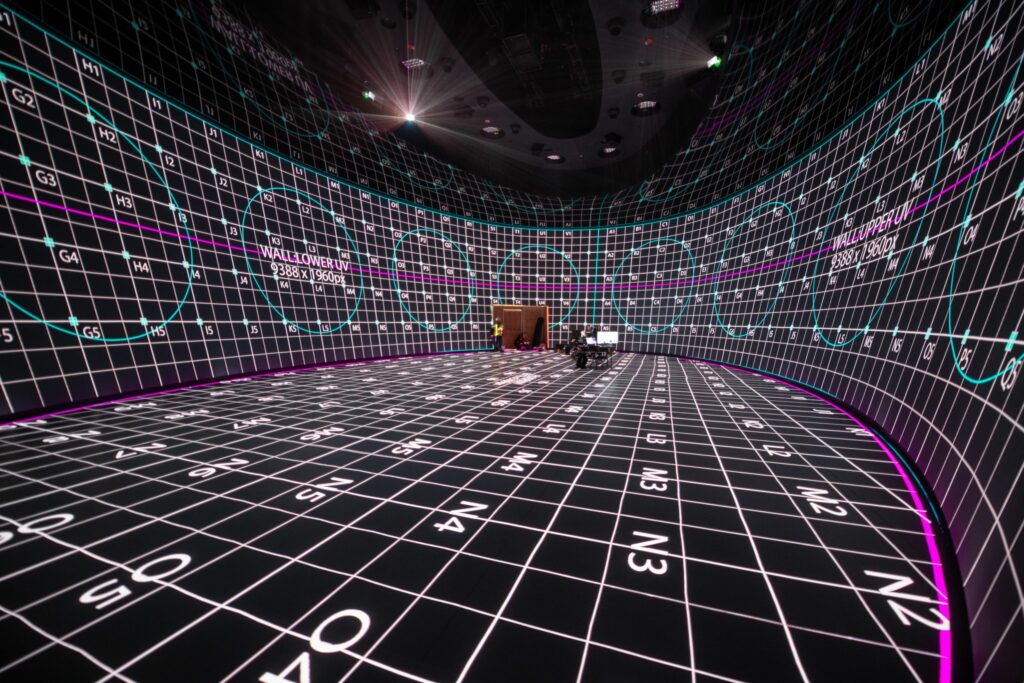New York City’s American Museum of National History will shortly open its new Richard Gilder Center for Science, Education, and Innovation, which rapidly takes shape in steel, glass and artfully shaped “shotcrete.” On Feb. 17, AMNH welcomes visitors to the Gilder Center for the first time.
With spectacular architecture designed by Studio Gang, the 230,000-square-foot Gilder Center project invites exploration of the fascinating, far-reaching relationships among species comprising life on Earth and reveals connections across the museum’s rich collections, trailblazing research initiatives, educational programs and exhibition galleries. Physically, Gilder Center connects many of the museum’s buildings, creating a continuous campus across four city blocks as envisioned more than 150 years ago. The new Gilder Center provides a dramatic embodiment of one of the museum’s essential messages: All life is connected.

Neoscape, Inc./© AMNH
“In a time when the need for science literacy has never been more urgent, we are thrilled and proud to be nearing the long-awaited opening date for the Richard Gilder Center for Science, Education, and Innovation, a major new facility that will transform both the work of our museum and the cultural landscape of New York City,” said Ellen V. Futter, president, American Museum of Natural History.
The Gilder Center, with exhibition design by Ralph Appelbaum Associates, will feature The Kenneth C. Griffin Exploration Atrium, a soaring, four-story civic space serving as a new gateway into the museum from Columbus Avenue, opening onto Theodore Roosevelt Park and creating a visitor path to Central Park West.
The David S. and Ruth L. Gottesman Research Library and Learning Center, a dynamic hub, connects visitors with the museum library’s unparalleled resources. Featuring sweeping views to the west, the fourth-floor facility will be open to the public and include a new scholars’ reading room; exhibition alcove; group study room; and space for visitors to stop by during the day to read or browse, as well as to attend organized programming or view collection displays that, among other things, share the history of science through holdings such as the museum’s Rare Book Collection.
The five-story Louis V. Gerstner Jr. Collections Core, a vertical-collections facility, features three stories of floor-to-ceiling exhibits representing every area of the museum’s collections in vertebrate and invertebrate biology, paleontology, geology, anthropology and archaeology, from fossil tracks to trilobites and antlers to pottery.

Neoscape, Inc./© AMNH
All told, Gilder Center will house close to 4 million scientific specimens, approximately 12 percent of the museum’s collection. The collections and exhibits on the first and second floors of the Collections Core are supported by the Macaulay Family Foundation.
The 5,000-square-foot Susan and Peter J. Solomon Family Insectarium, the first museum gallery in more than 50 years also opens, dedicated to the most diverse and critically important group of animals on earth. Featuring live and pinned insects and graphic and digital exhibits, the Insectarium will feature many of the 30 orders of insects, helping visitors explore the vital roles insects play in different ecosystems. Oversized models of honeybees mounted overhead will draw visitors through the gallery toward a monumental hive at the west end. Along the way, visitors pass under a transparent skybridge built as a route for live leafcutter ants in one of the world’s largest leafcutter ant displays. Touchscreens provide displays of insects of the boroughs of New York City, and a sound gallery surrounds visitors with the music of Central Park’s insects and offers the ability to feel the corresponding vibrations.
The year-round, 3,000-square-foot Davis Family Butterfly Vivarium allows visitors to mingle with up to 80 species of free-flying butterflies. This gallery offers opportunities to observe butterflies, one of nature’s vital environmental barometers, in various micro-environments ringing a meandering route. Visitors will be able to identify the butterflies they see by referring to an ID board featuring an illustrated card for each species in flight, updated daily. With the assistance of staff, visitors can view butterflies through a digital microscope.
Invisible Worlds, an extraordinary, 360-degree immersive science-and-art experience offers a breathtakingly beautiful and imaginative, yet scientifically rigorous window into the networks of life at all scales. Invisible Worlds will be shown in a custom venue that builds on the museum’s long tradition of transporting visitors across the world via its iconic habitat dioramas and throughout the universe in its science visualization-driven Hayden Planetarium Space Shows.

Timothy Schenck /© AMNH
Visitors will pass through an introductory gallery designed by the museum’s exhibition department that flows into a wide space as large as a hockey rink, with 23-foot-high walls that surround visitors with projections at all scales and mirrors at ceiling height suggesting infinity. A looping 12-minute immersive experience reveals all life on Earth is interconnected, from the building blocks of DNA to ecological interdependencies in forests, oceans and cities to communication made possible by trillions of connections within the human brain. At key moments, visitors become part of the story as their own movements affect the images of living networks depicted all around.
Gilder Center’s Griffin Atrium opens onto Theodore Roosevelt Park, creating a visitor path to Central Park West, and invites visitors to explore all the museum has to offer. Once inside, Griffin Atrium, a soaring, canyon-like space with bridges and openings, connects visitors physically and visually to the multiple levels of new exhibition galleries, education spaces and collections facilities within, imparting a sense of discovery to the building. This space, like much of Gilder Center, is formed by spraying structural concrete directly onto rebar without traditional formwork. This technique, known as “shotcrete,” was invented by museum naturalist and taxidermy artist Carl Akeley. Once cured, it is finished by hand, demonstrating the fluid quality of the material.
The Gilder Center project includes improvements to the adjacent portion of Theodore Roosevelt Park, with a new landscape design by Reed Hilderbrand that adds seating and gathering areas, expands circulation, revitalizes plantings and enhances park infrastructure.
Improvements to Theodore Roosevelt Park will be completed in phases. Renovations to the northwest corner, where the Nobel Monument is located, were completed last fall, and infrastructure enhancements to the remaining park areas, including the park entrance on Columbus Avenue, the Margaret Mead Green and spaces adjacent to the museum’s service drive, will open concurrently with Gilder Center in February. Plantings across the site are ongoing and scheduled to be completed during the 2023 spring planting season. Restoration of the streetscape in front of Gilder Center on Columbus Avenue will also be completed in spring 2023.
Reservations for timed-entry admission are required; facial coverings are strongly recommended for all visitors ages 2 and up. The museum is open daily, 10 a.m.–5:30 pm. For New York, New Jersey or Connecticut residents, the amount you pay for general admission tickets is up to you.
Read This Next

Introducing
FX Excursions
FX Excursions offers the chance for once-in-a-lifetime experiences in destinations around the world.
#globility
Insta FeedMay 2025
May 7, 2025LEED Certifies a Growing List of Properties Worldwide
Surrounded by more than 200 acres of protected forest in Sri Lanka’s Cultural Triangle, Heritance Kandalama was the world’s first resort to be LEED certified, a feat accomplished in 2000 just two years after the U.S. Green Building Council launched the Leadership in Energy and Environmental Design certification program. The 5-star property treats and repurposes 100 percent of its wastewater and effluents and works to achieve its goal of zero waste reaching landfill, among other sustainability efforts.
Sponsored Content
Seoul: Your Next MICE Destination
Seoul has rapidly become a leading global MICE hub, known for its rich culture, advanced technology and strong economy. As the capital of South Korea, it offers a strategic location in East Asia and a booming cultural influence through K-pop, K-movies, Korean cuisine and K-dramas. With its vibrant atmosphere and business-friendly environment, Seoul is increasingly the top choice for MICE organizers and corporate travelers seeking connection and collaboration.
eFlyer Reviews
May 7, 2025ZURiTO Review
Basque cuisine, known for its bold flavors and refined preparation, is wildly popular in cities across Europe, but has been slower to appear in the United States. However, Boston has just added its first Basque restaurant.
eFlyer News
May 7, 2025United Airlines Reinstates Washington Dulles–Albuquerque Route
This spring, United Airlines adds a daily, non-stop flight between Albuquerque International Sunport and Dulles International Airport in Washington, D.C. Set to begin service May 22, the flight will be operated by an Airbus A319ceo until December, in which the aircraft will switch to a Boeing 737-300.
Sponsored Content
Sail Unique with Explora Journeys
SAIL UNIQUE: A New Chapter in Luxury Ocean Travel Imagine a place where modern European elegance meets the rhythm of the sea — where time slows down, and every detail is crafted to inspire connection and quiet indulgence. This is Explora Journeys, the luxury lifestyle ocean brand from MSC Group created to redefine how we explore the world.
eFlyer News
May 7, 2025Fort Lauderdale Welcomes New All-Suite Hotel
The former Hilton Fort Lauderdale Beach Resort emerges as a new, all-suite Hilton property, further elevating this Florida city as a premier lifestyle destination. Beach House Fort Lauderdale, a Hilton Resort features refreshed interiors and new modern amenities, including new culinary concepts.
May 2025
May 5, 2025Costa Rica Lures with Modern Amenities, Rural Charm and a Simple Way of Life
When I first visited Costa Rica, I was ostensibly there for business. But after a few days in this tropical paradise, my trip started to feel more like a vacation than work. This isn’t to say I neglected my obligations, rather that my work meetings felt more pleasurable (and productive) than usual. The gorgeous jungle landscape combined with the pura vida lifestyle is a simply infectious combination, and it’s unsurprising the nation consistently ranks as the most popular tourist destination in Central America.
Sponsored Content
Royal Air Maroc Introduces Groundbreaking Safety Video: A Captivating Invitation to Discover Moroccan Heritage
Royal Air Maroc continues to elevate the passenger experience with the launch of its new in-flight safety video — a cinematic journey that seamlessly blends essential safety instructions with a celebration of Moroccan cultural heritage.
Slideshow
May 5, 20256 Reasons to Put Kansas City, Missouri, on Your Travel List
It’s time to start dreaming of your next trip. Here’s some destination inspiration for you. Take a visual journey through Kansas City, Missouri, with us.
ShareThis